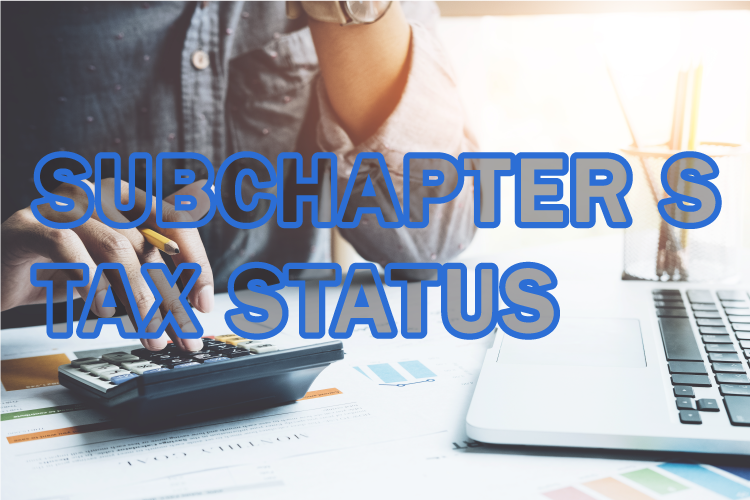What is Subchapter S Tax Status?
 Entrepreneurs aim to minimize tax obligations when it comes to IRS taxation. Decades ago, entrepreneurs had very few options when it came to how the entities were taxed by the IRS. The traditional C Corporation posed challenges with double taxation, where profits were taxed at the corporate level and then again at the individual level when distributed as dividends. On the other hand, sole proprietorship and partnership structures lacked asset protection, leaving personal assets vulnerable to business liabilities. In 1958, the Treasury Department introduced the "S Corp" or Subchapter S tax status as a solution. The S Corp provides a unique tax structure that allows business owners to enjoy the benefits of limited liability while avoiding double taxation. This tax status has since become a popular choice for small businesses and startups looking for a tax-efficient and flexible business structure.
Entrepreneurs aim to minimize tax obligations when it comes to IRS taxation. Decades ago, entrepreneurs had very few options when it came to how the entities were taxed by the IRS. The traditional C Corporation posed challenges with double taxation, where profits were taxed at the corporate level and then again at the individual level when distributed as dividends. On the other hand, sole proprietorship and partnership structures lacked asset protection, leaving personal assets vulnerable to business liabilities. In 1958, the Treasury Department introduced the "S Corp" or Subchapter S tax status as a solution. The S Corp provides a unique tax structure that allows business owners to enjoy the benefits of limited liability while avoiding double taxation. This tax status has since become a popular choice for small businesses and startups looking for a tax-efficient and flexible business structure.
Tax Benefits of Subchapter S Status
Once a business has successfully elected Subchapter S status, it becomes a pass-through entity for tax purposes. This means that the profits and losses of the business are passed through to its shareholders or members, who then report them on their personal tax returns. As a result, the business itself does not pay federal income tax, which can lead to significant tax savings for both the business and its owners.
Through Subchapter S status, small businesses can avoid the burden of double taxation that typically plagues C corporations. This advantageous classification enables them to retain a larger portion of their earnings, which can then be reinvested back into the company. The additional capital obtained can be leveraged to fuel growth, expand the workforce, or even allocate resources towards innovative technologies and updated equipment.
The pass-through nature of Subchapter S status provides flexibility in the distribution of profits to the shareholders or members. Unlike C corporations, where dividends are subject to double taxation, shareholders or members of an S corporation can receive distributions in a tax-efficient manner. This can be particularly advantageous for business owners who rely on business income as their primary source of personal financial support.
Obtaining Subchapter S status can be a strategic tax planning move to consider for eligible businesses, offering significant benefits potentially.
How to Elect Subchapter S Status
To elect Subchapter S status, a business must file Form 2553 with the IRS. For new companies, this means filing within two months and 15 days of its formation. For existing companies, the form must be filed before the 15th day of the third month of the tax year in which the election will take effect. For example, if an existing business wants Subchapter S status for the 2024 tax year, the form must be filed by March 15, 2024. Informing the Delaware Division of Corporations about the election of Subchapter S tax status is not a requirement. This election solely concerns the company and the IRS in terms of taxation.
Restrictions on Electing Subchapter S Status
While the tax benefits of Subchapter S status are attractive, there are some restrictions that businesses must adhere to if they elect this status. Some of the main restrictions include:
- The business must be a corporation or LLC formed in the US
- The business can have no more than 100 shareholders
- Shareholders must be individuals (US citizens or resident aliens), estates, or certain trusts and cannot be corporations or partnerships
- The business can only issue one class of stock
If a Delaware corporation or LLC meets these requirements, it can file Form 2553 with the IRS to elect Subchapter S status.
Conclusion
In conclusion, Subchapter S status offers significant tax advantages for Delaware corporations or LLCs. However, there are restrictions that must be met in order to elect this status. Business owners should consult with a tax professional or attorney to ensure they meet all requirements and properly elect Subchapter S status with the IRS for their business. By taking the necessary steps, businesses can enjoy the tax benefits of Subchapter S and potentially increase their profits. Form your new Delaware LLC or Corporation now to take advantage of the Subchapter S tax status!!!
*Disclaimer*: Harvard Business Services, Inc. is neither a law firm nor an accounting firm and, even in cases where the author is an attorney, or a tax professional, nothing in this article constitutes legal or tax advice. This article provides general commentary on, and analysis of, the subject addressed. We strongly advise that you consult an attorney or tax professional to receive legal or tax guidance tailored to your specific circumstances. Any action taken or not taken based on this article is at your own risk. If an article cites or provides a link to third-party sources or websites, Harvard Business Services, Inc. is not responsible for and makes no representations regarding such source’s content or accuracy. Opinions expressed in this article do not necessarily reflect those of Harvard Business Services, Inc.

